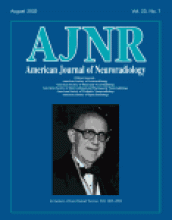Research ArticleBrain
Detection and Characterization of Very Small Cerebral Aneurysms by Using 2D and 3D Helical CT Angiography
J. Pablo Villablanca, Reza Jahan, Parizad Hooshi, Silvester Lim, Gary Duckwiler, Aman Patel, James Sayre, Neil Martin, John Frazee, John Bentson and Fernando Viñuela
American Journal of Neuroradiology August 2002, 23 (7) 1187-1198;
J. Pablo Villablanca
Reza Jahan
Parizad Hooshi
Silvester Lim
Gary Duckwiler
Aman Patel
James Sayre
Neil Martin
John Frazee
John Bentson

Submit a Response to This Article
Jump to comment:
No eLetters have been published for this article.
In this issue
Advertisement
J. Pablo Villablanca, Reza Jahan, Parizad Hooshi, Silvester Lim, Gary Duckwiler, Aman Patel, James Sayre, Neil Martin, John Frazee, John Bentson, Fernando Viñuela
Detection and Characterization of Very Small Cerebral Aneurysms by Using 2D and 3D Helical CT Angiography
American Journal of Neuroradiology Aug 2002, 23 (7) 1187-1198;
Detection and Characterization of Very Small Cerebral Aneurysms by Using 2D and 3D Helical CT Angiography
J. Pablo Villablanca, Reza Jahan, Parizad Hooshi, Silvester Lim, Gary Duckwiler, Aman Patel, James Sayre, Neil Martin, John Frazee, John Bentson, Fernando Viñuela
American Journal of Neuroradiology Aug 2002, 23 (7) 1187-1198;
Jump to section
Related Articles
- No related articles found.
Cited By...
- Nonsphericity Index and Size Ratio Identify Morphologic Differences between Growing and Stable Aneurysms in a Longitudinal Study of 93 Cases
- Autosomal dominant polycystic kidney disease and the heart and brain
- Larger size ratio associated with the rupture of very small (<=3 mm) anterior communicating artery aneurysms
- Vascular Graft Infections, Mycotic Aneurysms, and Endovascular Infections: A Scientific Statement From the American Heart Association
- Use of Follow-Up Imaging in Isolated Perimesencephalic Subarachnoid Hemorrhage: A Meta-Analysis
- Should Patients with Autosomal Dominant Polycystic Kidney Disease Be Screened for Cerebral Aneurysms?
- Interpretation Errors in CT Angiography of the Head and Neck and the Benefit of Double Reading
- Negative CT Angiography Findings in Patients with Spontaneous Subarachnoid Hemorrhage: When Is Digital Subtraction Angiography Still Needed?
- Recommendations for Imaging of Acute Ischemic Stroke: A Scientific Statement From the American Heart Association
- Configuration of intracranial arteries and development of aneurysms: A follow-up study
- Mutlidetector CT: new horizons in neurological imaging
- CT Angiography "Spot Sign" Predicts Hematoma Expansion in Acute Intracerebral Hemorrhage
- Brain imaging using multislice CT: a personal perspective
- Repeat Imaging for Intracranial Aneurysms in Patients with Autosomal Dominant Polycystic Kidney Disease with Initially Negative Studies: A Prospective Ten-Year Follow-up
- Characteristics of intracranial aneurysms in patients with familial subarachnoid hemorrhage
This article has not yet been cited by articles in journals that are participating in Crossref Cited-by Linking.
More in this TOC Section
Similar Articles
Advertisement











